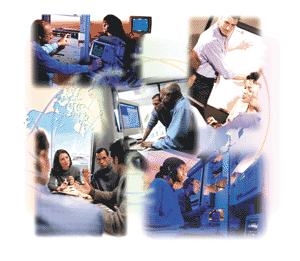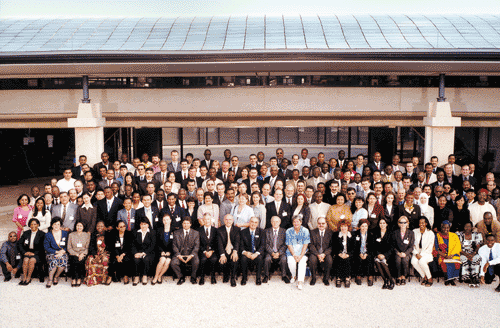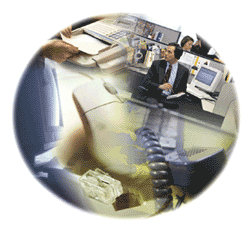
Photo: Avaya

Photo: Avaya
Creating new leaders for e-culture" was the theme of a recent global conference (20 to 24 August 2001) held at the Cable & Wireless Campus in Coventry (United Kingdom). ITU in its efforts to bridge the digital divide supports the creation of electronic culture while protecting and conserving local cultures and values. This global event was one such effort, bringing together as it did some 200 participants from 100 countries, four regional organizations, several non-governmental organizations (NGO) and UNAIDS. It was organized by the ITU Telecommunication Development Bureau's Human Resources Development Unit in collaboration with Cable & Wireless and the United Kingdom Telecommunication Academy (UKTA).
Participants discussed the many facets of e-culture: e-governance, e-commerce, e-learning, e-society and e-health. Above all, they sought to identify the critical issues in the migration to e-culture and to define the role of telecommunications and of the human resources development function in this process. They also focused on how to prepare managers of communications and senior executives for e-culture and on finding international or multilateral cooperation opportunities for the benefit of developing countries. The conference was chaired by David Mellor, President of the Cable & Wireless Virtual Academy. He was ably assisted by two Vice-Chairmen: Idrissa Touré, Director of the Ecole Supérieure Multinationale des Télécommunications (ESMT), one of the two regional African telecommunication training institutes which ITU is assisting to evolve into Centres of Excellence, and Héctor Rodríguez, Executive Secretary of the Comisión Técnica Regional de Telecomunicaciones Centroamérica (COMTELCA) — the technical commission for Central America with subcommittees for regulators and operators.
| *This article is based on a report from Barbara Wilson of the ITU's Human Resources Development Unit, who covered the global conference on "creating new leaders for e-culture" in Coventry for ITU News. The full report is available at www.itu.int/ITU-D/hrd. |

Some 200 participants in the global conference on "creating new leaders for e-culture" join in a
"family" photo at the Cable & Wireless campus in Coventry (United Kingdom). The Conference was
organized by the ITU Telecommunication Development Bureau's Human Resources Development Unit in collaboration with
Cable & Wireless and the United Kingdom Telecommunication Academy (UKTA)
(ITU 010077)
From the meeting, the challenges remain enormous but now is the time to truly prepare for that e-culture future. Louis Galea, Minister of Education of Malta, who gave the keynote address at the opening ceremony, remarked: "The sad fact is that the majority of the six billion people who inhabit our planet have been completely shut out of the digital revolution and the promises it holds. How can telecommunications be used to usher in e-culture, especially in those areas where the most basic of e's, electricity, is still missing?"
As part of its strategy to facilitate the integration of developing countries into the information society, ITU plans to hold discussions with a wide-range of high-level officials in developing countries. A key objective is to assist such officials establish national strategies that aim to create an e-culture that introduces the use of the Internet at all levels of the education system and increases electronic applications such as tele-education, telemedicine, telework-ing and e-commerce to benefit all segments of their population.
Participants were primarily from the various branches of the communications sector (regulation, finance, management, law, human resource management and development). Both education and health sectors were represented. All participants were directly concerned with the impact and consequences of the new communications environment on their communities and their organizations. Each day of the conference focused on a different aspect of e-culture.
Information and communication technologies (ICT) have opened the door to new opportunities for governments and citizens alike to communicate with each other more easily and effectively. Many governments have created websites enabling the public to access information they need in their personal and professional lives. For example, in some countries, rural inhabitants can now file an online building permit application without having to travel days to the capital city; farmers can receive the most up-to-date vaccination alerts for their livestock; and consumers can check government vehicle safety reports before buying a new car. All of this is possible from public Internet access sites or Internet cafés. Of course, the ease with which official information now flows also poses new challenges, including protection of privacy and how to reach those who lack computer or language literacy. The discussion on e-governance revolved around:
What is a socially just society?An interesting definition of what constitutes a "socially just society" emerged from the conference. A socially just society was defined as one that:
|
The e-culture phenomenon is a result of the profound transformation in the ICT sector. For example, the cost of technology is falling, digital mobile technology and access to broadband networks and services are becoming more widely available, and the Internet protocol (IP) is emerging as the platform for delivering convergent services. These changes are introducing new challenges (as well as opportunities) as e-transactions are conducted across geographical boundaries increasing the need for an environment that encourages the use of technologies for trust and security. As leaders from all nations strive to be part of this digital revolution and as service providers seek new business models and technologies to deliver value-added e-services, it is evident that several factors contribute to the success of e-services deployment. Participants discussed:
With the rapid and fundamental changes occurring in the telecommunication and education sectors, e-learning has a key role to play in coping with this reality. One of the greatest challenges facing most countries is how they can change and prepare themselves to introduce e-learning and so improve the effectiveness and efficiency of their learning systems. Participants discussed some of the fundamental questions that governments, educational institutions, management (including managers for human resources management and development) must address in order to achieve their objectives to improve learning and widen the scope of access.
"In the midst of this fast process of change, academic institutions are being urgently invited to assess whether their educational, training, and research programmes are in fact developing the right milieu for e-culture and e-governance to take route and flourish. The key to the success of such initiatives is in education, training, and innovation as much as it is in the raw deployment of technology. We are convinced that we can only and truly bridge the digital divide by going back to basics — ensure that absolutely no child lacks the basic literacy and ICT skills by the time one ends Primary School."
Louis Galea,Minister of Education of Malta in his keynote address to the global conference on "creating new leaders for e-culture "
Mr Galea told participants: "In the midst of this fast process of change, academic institutions are being urgently invited to assess whether their educational, training, and research programmes are in fact developing the right milieu for e-culture and e-governance to take route and flourish. The key to the success of such initiatives is in education, training, and innovation as much as it is in the raw deployment of technology. We are convinced that we can only and truly bridge the digital divide by going back to basics — ensure that absolutely no child lacks the basic literacy and ICT skills by the time one ends Primary School." By way of an example, in Malta, the government has embarked on a three-year project to provide a fast and efficient Internet connection in all schools in the country.

Photo: Avaya
The contribution of e-culture to the various needs of life is fundamental for the evolution towards a know-ledge and information society. Such evolution should develop towards a more equitable society. Ques-tions and issues of gender, social inequalities, lack of access, illiteracy, to name but a few, should be taken into account when defining an ICT policy and promoting e-culture, participants noted.
The knowledge and information society can and should be a more just society where the tools provided by e-culture are used to minimize the inequalities found in society today. Health is without doubt one of the basic needs of each individual and of society.
In order to draw up recommendations on this theme, participants focused on:
For some of the participants, e-society brings with it a new milieu of values, culture, behaviour, work patterns and organizational designs — with interactions within organizations and external to them changing beyond recognition. The real challenge is whether all people are ready to change the way they do things.
The final report of the global conference has been endorsed by a meeting of the Special Group on Human Resources Development within ITU's Telecommunication Development Sector (ITU–D). This meeting that took place right on the heels of the conference has requested that ITU organize conferences such as the Coventry global event every two years. The conclusions and recommendations of the conference, along with all related documents, are available at www.itu.int/ITU-D/hrd.